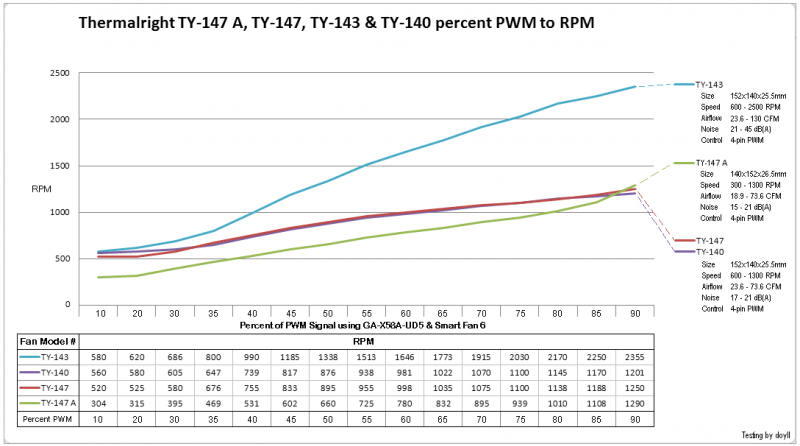You are using an out of date browser. It may not display this or other websites correctly.
You should upgrade or use an alternative browser.
You should upgrade or use an alternative browser.
How would a PMW signal split between 2 different fans work?
- Thread starter new boy
- Start date
More options
Thread starter's postsIt works just great.
PWM fans use 12volt power on a constant lead with the 4th pin on PWM fan header sends a PWM signal to the fan's built in PWM pcb where it pulses the 12v power going to the fan to control the fan speed.
The signal from one PWM fan header can usually control 8 to 10 fans no problems, but there are a few fans (like some Corsair) that do not play well with others. Some of them will not work if only 2 or 3 of them are on a splitter.
PWM fans use 12volt power on a constant lead with the 4th pin on PWM fan header sends a PWM signal to the fan's built in PWM pcb where it pulses the 12v power going to the fan to control the fan speed.
The signal from one PWM fan header can usually control 8 to 10 fans no problems, but there are a few fans (like some Corsair) that do not play well with others. Some of them will not work if only 2 or 3 of them are on a splitter.
It works just great.
PWM fans use 12volt power on a constant lead with the 4th pin on PWM fan header sends a PWM signal to the fan's built in PWM pcb where it pulses the 12v power going to the fan to control the fan speed.
The signal from one PWM fan header can usually control 8 to 10 fans no problems, but there are a few fans (like some Corsair) that do not play well with others. Some of them will not work if only 2 or 3 of them are on a splitter.
So does it "ask" them to stay at a certain RPM rather than a % of their max speed?
So a 1,000RPM "brand X" fan, and a 2,000RPM "brand Y" fan set at 50% (PMW signal going to brand X) in theory causes brand x to run at 500 RPM and brand Y to run at 1,000 RPM or both at 500RPM?
EDIT - I know stuff happens and things dont alway go to plan, but is that the basics?
Last edited:
So does it "ask" them to stay at a certain RPM rather than a % of their max speed?
a percentage
a percentage
OK, thanks for the confirmation.
So does it "ask" them to stay at a certain RPM rather than a % of their max speed?
So a 1,000RPM "brand X" fan, and a 2,000RPM "brand Y" fan set at 50% (PMW signal going to brand X) in theory causes brand x to run at 500 RPM and brand Y to run at 1,000 RPM or both at 500RPM?
EDIT - I know stuff happens and things dont alway go to plan, but is that the basics?
The percent of PWM signal "demands", but the programing on on fan pcb determine what the actual pulse rate is. Good example is Thermalright TY-147 and TY-147A. Same fan, different PCB program. TY-147 is 550-1300rpm, TY-147A is 300-1300rpm ramping up slowly to about 1150, then pulse speeds up ore rapidly to 100%

Thanks for the thanks. 
Very few motherboards use rpm from fan. It is for our use. Motherboards generally control percent PWM signal (for PWM) and voltage level (for variable voltage) base on heat. More heat means higher PWM percentage or higher voltage to move more air to accomplish the cooling. Motherboard doesn't care what the rpm actually is expect for the "low rpm warning" or similar warning in case fan is not working/running .. and even this is for user use, not mobo. Mobo will shutdown system based on heat, but none I have used do it based on rpm. The RPM signal from fan is for users to see how fast the fans are actually running

Very few motherboards use rpm from fan. It is for our use. Motherboards generally control percent PWM signal (for PWM) and voltage level (for variable voltage) base on heat. More heat means higher PWM percentage or higher voltage to move more air to accomplish the cooling. Motherboard doesn't care what the rpm actually is expect for the "low rpm warning" or similar warning in case fan is not working/running .. and even this is for user use, not mobo. Mobo will shutdown system based on heat, but none I have used do it based on rpm. The RPM signal from fan is for users to see how fast the fans are actually running

